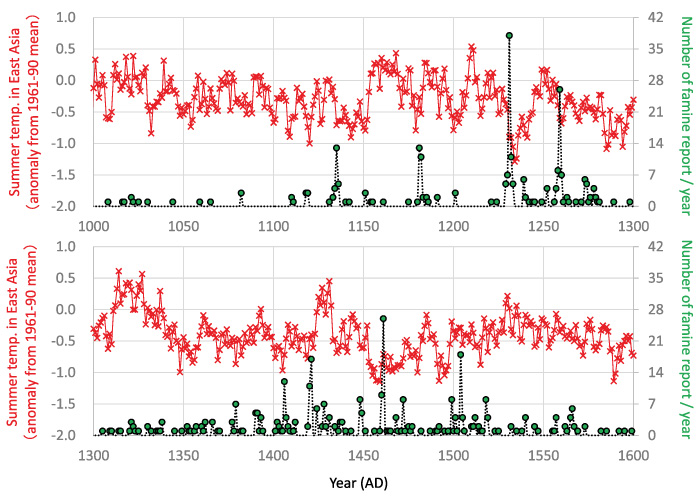Societal Adaptation to Climate Change:
Integrating Palaeoclimatological Data with Historical and Archaeological Evidences
We have reconstructed the last 5000 years of climate variations in Japan and Asia using high-resolution paleoclimate archives such as tree rings, coral rings, old diaries, and sediments. Tree-ring cellulose oxygen isotope ratios have disclosed variations in summer precipitation (annual resolution) since the Jomon-era, by which we have elucidated climate variations behind Japanese history at all time scale from 1 to 1000 years. Comparisons of the paleoclimate data with paleographic and archaeological archives have been drastically improving our understanding of the climate-history relationship in Japan. Numerous works of literature on disasters like cold summer, flood and drought since the Ancient period have been confirmed paleoclimatologically. We have found a tight relationship between climate variations and socio-economic indices like agrarian production, prices of commodities and regional population in Medieval and Early Modern periods and the correspondence of village distribution and irrigation development to precipitation changes in the Prehistorical period. We have also developed a new dendrochronological method to date archaeological wood using oxygen isotope ratios for better chronological comparisons of climate change and the ways in which prehistorical people responded. By comparing the paleoclimate data with famine and war records, we have realized that multi-decadal large variations in temperature and/or precipitation bring serious negative impacts on human societies (Figure 1). Moreover, we have discovered the fact that multi-decadal climate variability is enhanced regularly at about 400-year intervals when simultaneous political regime shifts occur over wide areas including Japan and China, which suggests the importance of climate variations as a key factor of global history studies.
Although we have confirmed tight linkages between climate and Japanese history, this was not the final goal. We can contribute to studies of global environmental issues in two ways besides making science-based predictions of future climate. One is to extract universal lessons from historical climate adaptations. Although past people often got into difficulties when they encountered the enhancement of multi-decadal climate variation, they eventually overcame it by modifying societal systems. We should learn from historical lessons to make new sustainable societies by overcoming difficulties such as enhancement of social inequality due to natural and social environmental changes. Our work also contributes to the issue of faithfully confronting the diversity of past people. As our sense of values is different from those of Pre-Modern people, values of future generations must be different from those of ours. To establish a “futurable” society, one of RIHN’s aims, we should recognize how temporal change and value change are linked, so that we may understand the real sense and meaning of people and societies responses to climate variation.
We are editing six Japanese volumes and one English volume to synthesize project results as well as many original papers and books in the fields of paleoclimatology, history, and archaeology. We have already started a new inter-disciplinary research project on “reevaluation of calendar ages and climate-history relationship in the prehistorical Japanese archipelago using tree-ring oxygen isotope ratios” by collaborating with many archaeological investigators belonging to many local governments in Japan. A huge amount of paleoclimate data obtained in this project are to be used in the framework of historical big-data analyses on paleography and disaster prevention and reduction research for contemporary societies.

Figure 1 Variations in East Asia summer temperature (red: reconstructed from tree ring width database in Asian wide region) and famine reports in Japan (green: number of old documents from each year containing famine-words) during Medieval period.
